- This article comprehensively
tells you about the different forms of art, dance, crafts, music and textile
traditions of Punjab.
In part one
we covered Maharashtra. Part two is about Punjab - literally, the land of five
rivers! For the uninitiated, Punjab is synonymous with swathes of swaying, green
fields, replete with exuberance, self-sufficiency, and satisfaction. Area-wise,
it is the 20th largest state in the republic of India. It is home to
different communities who revel in the beauty of the land’s strategic location,
rivers, hills, places of worship, and vibrant festivals.
Over thousands of years, multitude
of factors such as climatic, political, foreign invasions, regional, religious,
historical, and so on have led to the emergence of a peculiar culture of the
state. Here’s a deep dive into the crafts and performing arts of the state - a noteworthy
window to the culture of Punjab.
1. Crafts
of Punjab
Basketry
The womenfolk in Punjab took to
making baskets to carry multiple utensils and other household articles at once.
Carrying multiple items in a basket at once eased the task of carrying these
articles, one at a time. Baskets, assembled with thin straws of wood that
remain after wood shaving, were merely for their convenience and were not
considered as artwork or pieces of home decor.
However, as their skill gained
popularity, women began to try creative ways to embellish the baskets they
made. Thus, the craft of basketry came to be practised widely across the state
of Punjab. Today, it is celebrated as one of the most prominent crafts of
Punjab.
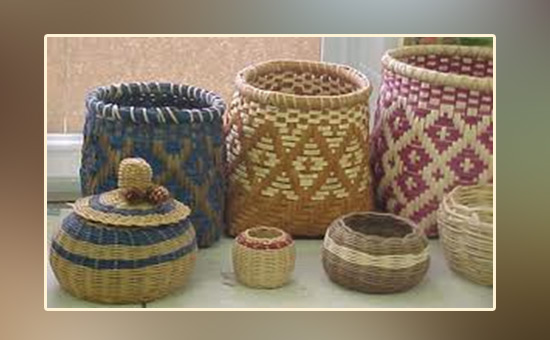 Baskets made in Punjab.
Baskets made in Punjab.
Woodwork
Punjabi artisans engaged in woodwork are the much sought-after artisans (read carpenters and craftsmen) across the country. The state of Punjab proudly promotes its wooden furniture and woodcrafts. Wooden beds with beautiful backrests, intricately designed with mirrors are renowned and find patronage of those with an eye for traditional furniture.
Among other furniture, wooden stools
made with low seats, called Pidhis, are also sought after. Carved from wood, covered with lacquer, and woven with colourful threads, the Pidhis are a functional product that adorns the homes of those with a taste in ethnic décor. The curl-ended hand fan made from wood called Kundaldar Pakkhi, is so famous that tourists visiting Punjab make a
beeline to purchase them at local stores.
The regions of Batala, Amritsar, Kartarpur,
and Hoshiarpur are known for skilled artisans engaged in wood carving. Beautifully
carved wooden vanity and jewellery boxes, bangle stands, toys, mirror frames,
trays, dining chairs and tables, and decorative art pieces, inlayed with ivory
are exported by the state of Punjab.
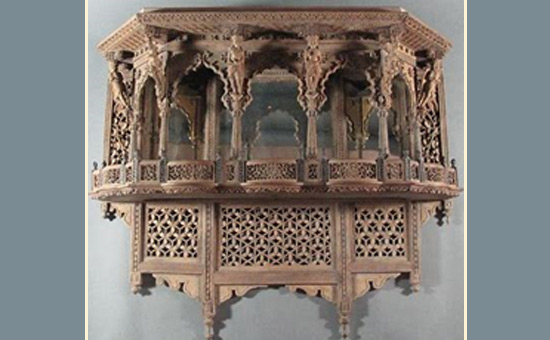 Examples of woodwork in Punjab.
Examples of woodwork in Punjab.
Needle
work
Needle work, by the proverbially
beautiful women of Punjab, is as exquisite as the women who design it. Phulkari, a fascinating needlework-based
textile folk-art deploys colourful threads that trace flower motifs and petal
shapes.
Phulkari is believed to be a symbol of marital bliss and hence Phulkari-designed scarves, shalwars, dupattas, handkerchiefs, bedspreads, odhanis, suits, and shirts find special presence during weddings and in the bridal trousseau. What’s striking is that no two phulkaris are alike and hence diverse designs make appearances on varied textures and fabrics.
 Dupatta made of Phulkari needle work.
Dupatta made of Phulkari needle work.
Punjabi
Juttis
Punjabi juttis - bright and
seeped in colour and verve, are a rage among those who visit Punjab! Juttis made
in Punjab are so light that cobblers refer to them as ‘shoes that even birds
could wear while taking flight.’ What’s equally appealing about the juttis is
that they are made of sweat-free cloth!
The golden and silver wires used
to weave designs into the juttis give them a heavy and luxurious appearance. The
richness of the juttis lies in their quality which is never compromised upon. These
days, different threads and colourful wires are used apart from the traditional
golden and silver wires to make the juttis more attractive and vibrant!
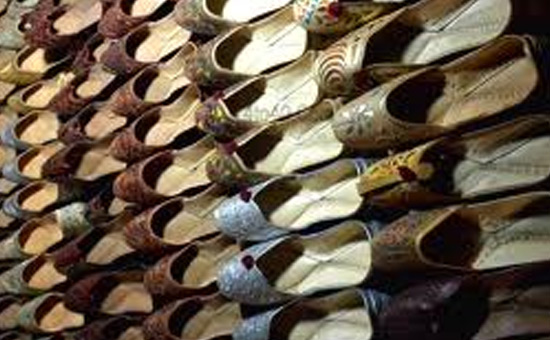 Punjabi Juttis.
Punjabi Juttis.
Pottery
Since clay is easily available
from any pond in the vicinity (each pond is called Chappar), clay pots find a special mention in the art forms of Punjab.
Each type of pot has a specific function to perform in the everyday lives of
the villagers.
Of these the Surahi and Ghara, pots
used for collecting and storing water respectively, are renowned. The pots, once
ready, are painted in different colours. Some are even decorated with small
coloured pieces of glass in unique spatial designs. Decorated clay pots have
made a big splash in the city markets of Punjab and are sold at a good price
today.
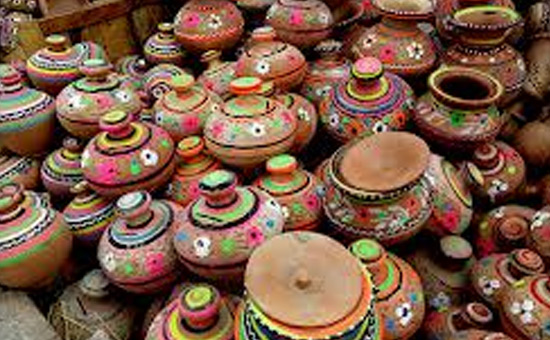 Clay pots made in Punjab.
Clay pots made in Punjab.
Toy
making
Quite like the clay pots, Punjab is famous for its clay toys. An interesting fact about clay toys made in Punjab is that one can trace their origins way back to the Indus Valley Civilization. The toys belonging to that era and the ones from a period much later in time bear a striking resemblance.
In fact, until recent times, traditional clay toy designs and toy-making technique had been quite the same, demonstrating knowledge and skill-sharing over generations. Clay toys are painted in animated colours and adorned with clothes. Sadly, with time, clay toys are being increasingly replaced by plastic and metal toys in city markets.
Toys made of wood and lacquer, and painted in bright colours such as yellow, red, green, and orange were traditionally made only in the Hoshiarpur, Jalandhar, and Kartarpur regions. The wood and lacquer toy-making industry is now spread evenly across the state.
Toys made of cloth and stuffed
with cotton, embellished with beads, tassels, feathers, tinsels, and buttons
are made by womenfolk in villages. Also, Punjab was once famous for its toys
made of straw.
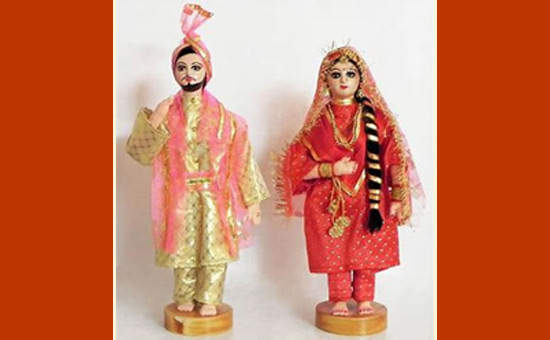 Clay toys made in Punjab.
Clay toys made in Punjab.
Mud
wall painting
People in Punjab believe in
invoking God’s blessings and warding off the evil eye with art, craft, and
beauty. Chowk Poorana, or mud wall paintings, is an art practised in every village household, passed down several generations. Punjabi women are known to paint their mud walls with beautiful scenes and stories from epics and mythology. They also paint images of festivals and dance forms on their mud walls, especially during auspicious occasions. These beautiful mud wall paintings are testimony to the belief in positivity, power, and energy that all women are bestowed with.
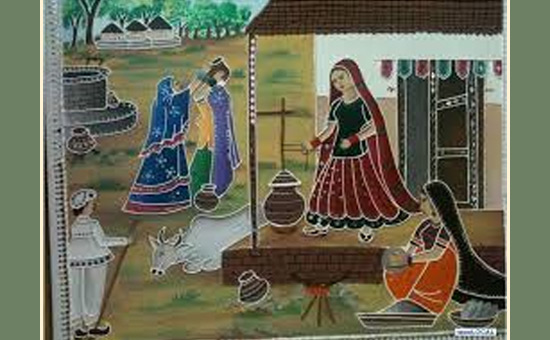 Mud wall painting in Punjab.
Mud wall painting in Punjab.
Hand
printing
The Chimba community in Punjab is
renowned for its beautiful art of hand printing on cloth. White cloth, provided
by customers is dyed with dyes obtained from vegetables, plants, and stones and
then hand-printed by the artisans. Hand printing is now done on cloth for daily
wear, handkerchiefs, prayer cloth, bed covers, and shamianas (tent covers).
Traditional dyes have been replaced by aniline dyes since they are cheap and
require much less labour.
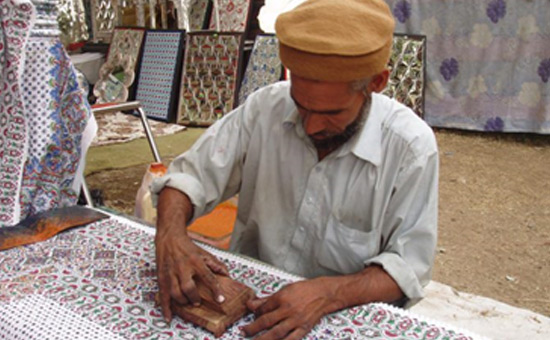 An artisan engages in hand block printing.
An artisan engages in hand block printing.
Kite
making
Punjabis are very fond of flying
kites and invest their available free time in making kites of different sizes.
Some kites are decorated with light materials such as feathers and straws and
are coloured in distinct pulsating hues. On Basant Panchami, a festival that
celebrates the onset of spring, Punjabis rejoice with kite flying festivities.
On this day there are kite flying competitions that entire families participate
in.
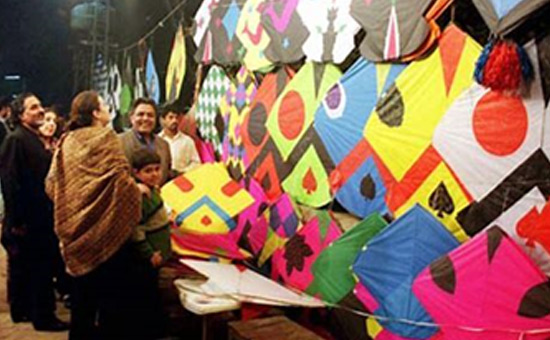 A family shopping for kites, a day prior to Basant Panchami.
A family shopping for kites, a day prior to Basant Panchami.
2. Performing
Arts of Punjab
Punjab is renowned for its distinct dance and music traditions. Important life events such as birth and death, love and separation, marriage and fulfilment, and so on are celebrated through the soulful music and dancing styles of Punjab.
Music of
Punjab
Punjabi folk music has expressive
forms such as the Dhadi, Tumba-Algoze, and Tappa among other regional variants.
Dhadi
This ballad-style of folk music
follows the principles of communal authorship. Dhadi singers – practically
illiterate simple village folk, dressed in all white with starched turbans,
would belt out ballads of heroism, love, and tragedy. They would sing about
characters immortalized in legends such as Hir-Ranjha and Mirza-Sahiba. A
similar ballad-style folk music found in the Malwa- Majha region is the tumba-algoze music.
Tappa
These are small verses inspired
by the routine lives of the village folk. Couplets and witty lines form the
core of some verses while serious elucidations of life form the core of others.
Lyrical verses are bound in music with instruments such as dhol, algoje,
sarangi, chimta, kato, supp, budgo, tumid, and dhad amongst others. Punjabi Tappe, a compilation of Tappa verses,
sung by the late legendary singer Jagjit Singh are treat to one’s ears!
Dances of
Punjab
Music, dance, and life are
inseparable in the state of Punjab. Traditional folk-dance forms such as
Bhangra, Gidda, Jhumar, Luddi, Dankara, Dhamal, Jaago, and Kikli are some of
the most prominent ones. These delightful Punjabi dance forms spread across the
world as people from Punjab moved continents for education and employment. Each
of these dance forms has its unique panache and comprises inimitable dance
steps. Known to be performed on different occasions and for different purposes,
let us explore each of them, individually.
Bhangra
Bhangra is the most famous dance
form out of all the traditional folk-dance forms of Punjab. Bhangra was
traditionally performed on Lohri and Baisakhi to celebrate the change of
seasons and harvest respectively. Today, bhangra is synonymous with the
celebratory nature of the Punjabis - the people of Punjab.
In present times, bhangra is
performed on all occasions such as birthdays, weddings, pre-wedding ceremonies,
festivals, and so on. In villages, during festivals, people belonging to
diverse social classes, gather at the village square and dance to classic
bhangra steps involving a lot of leaping and jumping, around those playing the
dhol.
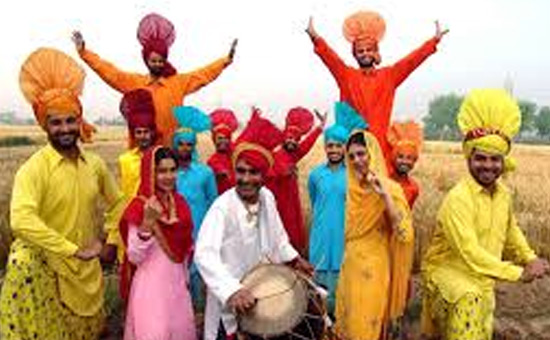 A Bhangra dance troupe.
A Bhangra dance troupe.
Gidda
Like Bhangra, Gidda is also one
of the most famous dance forms of Punjab. The gidda involves a signature
clapping of hands, and a dance to match the beats of the dhols and drums. The
dances are performed on the lines of bolis.
Bolis are small verses or couplets that are inspired by the daily
life of women, social life of the families, and even the political scenarios
which plays a vital role in the social and economic lives of the women of
Punjab. Humorous giddas such as banters with husbands and mothers-in-law as
well as serious ones like the stomach-pinching price hikes are performed by women
with a lot of enthusiasm. These days, Giddas have come to be performed in
association with bhangra and both the folk-dance forms have become almost inseparable.
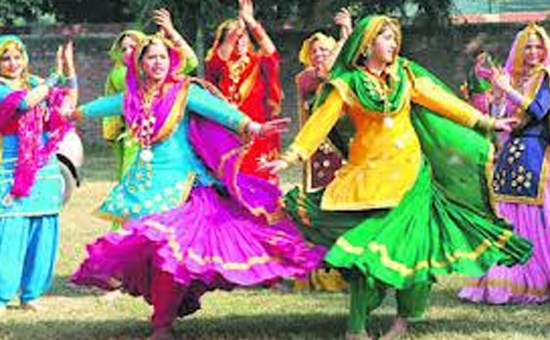 Gidda Dance.
Gidda Dance.
Jhumar
This dance form traces its
origins in Sandalbar, a small place in present-day Pakistan. The dance is
performed by women who circle around the drummer and sing verses as they dance.
It was carried to places in Punjab and Rajasthan, by artists travelling from
the Sandalbar town to promote their music and dance.
Luddi
Luddi is a celebratory victory
dance. It is mostly performed by male dancers as the dance involves extremely forceful
body movements. Dancers performing Luddi wear simple loose shirts, place one hand
on their back and the other in front of their faces and perform snake-like body
movements. The dancers perform these vigorous steps around the drummer present
at the centre of the formation. Very often, villagers join the dance and give
it a befitting finale with a round of bhangra.
Dankara
Dankara is also a celebratory
dance form typically performed by men during weddings. The characteristic dance
steps of dankara involve two men with staves of different colours dance to the
rhythm of beats around each other and then tap their sticks together. People
arrange to have special dankara performances during wedding ceremonies these
days.
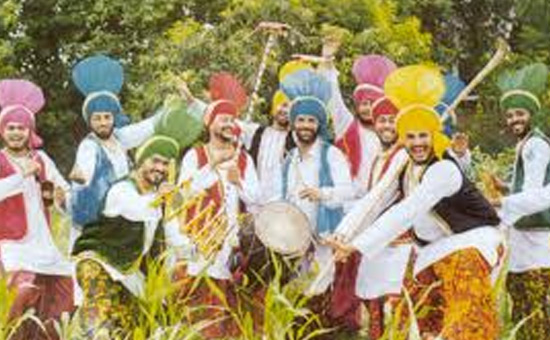 Dankara Dance.
Dankara Dance.
Dhamal
Dhamal, again a celebratory dance
form, is like bhangra. Several men dance together in a circle with steps quite like
those performed in bhangra, without detailed attention to formation and rhythm.
It is performed to merely relish the occasion.
Jaago
The word Jaago literally means a
call to wake up! People in Punjab love to celebrate weddings on a large scale. In
villages, almost the entire village or the community is invited to the wedding.
Women of the house announce the wedding to everyone by carrying pots (gaggars)
of water on their heads through the entire village and sing songs with lyrics meant
to tease people. They celebrate the upcoming nuptials of the girl in their
house by lighting candles and decorating the gaggars with colourful paint and
small pieces of colourful glass.
Kikli
Kikli is performed by women by
crossing their arms, holding each other’s hands, and dancing and whirling
around in circles while singing small couplets and verses of folk songs. Two,
four or six women perform this dance together in their courtyards to celebrate
different occasions!
Gatka
“Gatka is a complete martial system which uses spiritual, mental and physical skills in equal portions to help one defend themselves and others. It is a weapon-based art whose present form was created post 1857. “It gained popularity when the British banned the practise of Shastar Vidiya, which was punishable by death. The Punjabi word gatka refers to a wooden stick used in sparring matches. The term might have originated as a diminutive of the Sanskrit word gada or mace.”
“Indian Shastar Vidya (martial art weaponry skills) is a part of the vast Vedic traditions. It is a complete science of war from hand-to-hand combat to battlefield strategy. It was exported to the oriental world along with Buddhism and became a foundation for Chinese and Japanese martial art tradition".
It is a martial art form performed by the young and old alike that is specifically performed on Baisakhi and Gurupurab days to celebrate the tradition started by Sikh guru Hargobind Sahib after the martyrdom of Guru Arjan Dev. It is a sight to behold and is preceded and proceeded by a peaceful procession.
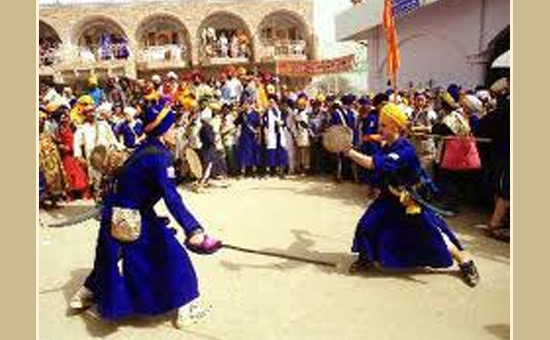 Gatka being played.
Gatka being played.
The people of Punjab are extremely warm and enhance social interactions with their personal exuberance and enthusiasm! They are energetic individuals who believe in celebrating life to the fullest – a sentiment justly depicted in their art forms!
To read all
articles by author
Also see
1. Gatka
performance Hola Mohala Anandpur
2. Fields of
Punjab
3. Read
more about Gatka
4. To know about Kerala Martial Art
Kalaripayattu